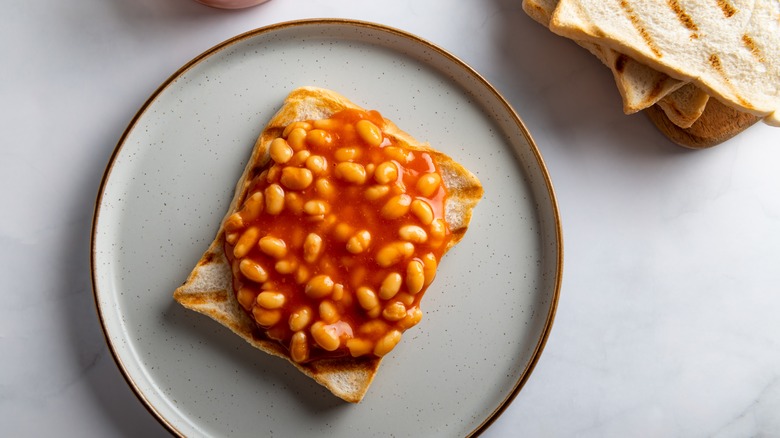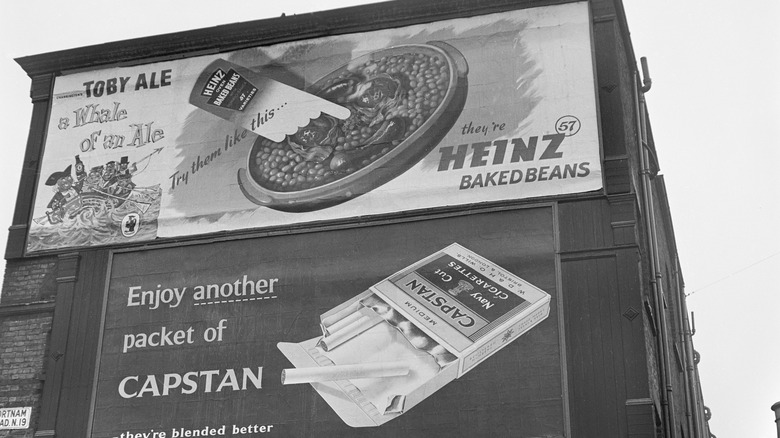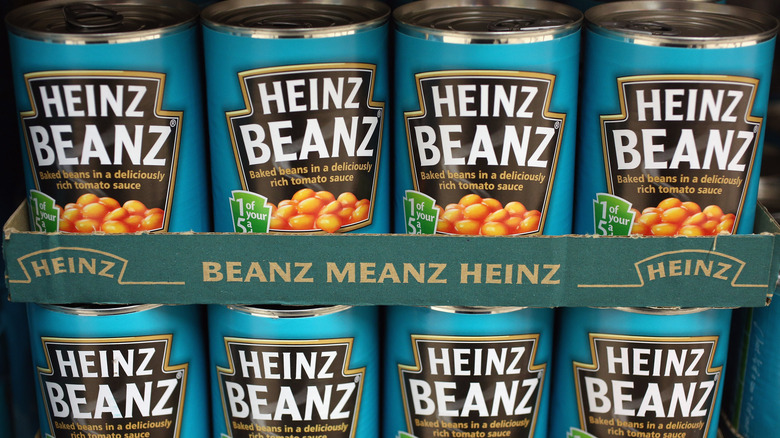The Marketing Ploy Behind The UK's Beans On Toast
We may receive a commission on purchases made from links.
While Britain has a certain reputation regarding food, few would turn down what is largely considered the country's national dish, chicken tikka masala, or the explosively named bangers and mash. Even fewer would claim they couldn't find something to enjoy in a full English breakfast or a Sunday roast. But some British foods can sometimes befuddle international observers, and few dishes are as surprising to newcomers as the quintessential British comfort food beans on toast.
Inexpensive and easy to make, beans on toast is a warm and cozy, protein-packed dish comprised simply of — you guessed it — toast and beans (okay, maybe with some butter on the toast and cheddar on the beans). While you may be envisioning Pork & Beans or Mexican spiced pinto beans spooned on top of bread and feel justifiably disconcerted by the prospect, many Brits will passionately inform you that the only acceptable bean variety for this dish is baked beans. More specifically, the tomato-based Heinz baked beans and only Heinz beans.
So, how did an American company producing beans in Pittsburgh produce such a staple in British culture? The prevalence of Heinz beans on toast isn't an accident or a coincidence. It's the successful result of a marketing campaign launched by an executive at the company.
The rise of Heinz beans in the U.K.
Launched in America in the late 19th century, Heinz baked beans are made by adding navy beans to a tomato sauce, then sealing them in cans and heating them in a pressure cooker until they reach 120 degrees Fahrenheit. The process removes harmful bacteria while also cooking beans and creating the brand's signature sauce.
With less smoky flavor and thinner consistency, the beans were more suited to a British palette and an American. Heinz beans were initially exported to the U.K. as a luxury item in 1886 and sold at the high-end department store Fortnum & Mason. But the popularity of the product grew so rapidly that, by 1905, a factory opened in the UK to meet the growing demand and make the product more economically accessible.
As for the iconic move of pouring them on top of toast? Heinz claims credit for this, too. While their beans became part of the full English breakfast in 1967 with the ad campaign "Beanz Meanz Heinz" (per Creative Review), an executive at the brand created the dish in 1972 to make the product a mealtime staple all day long. The effort was successful — especially when high rates of inflation and unemployment in1970s Britain made simple, inexpensive, filling foods all the more essential. But even after this turbulent period, the nation's love of beans persisted. Today, 43% of British folks say they eat baked beans every week, frequently served on toast (via The Express).
How to make beans on toast
If you want to try this classic dish at home, you'll want to make sure you're using the right style of beans. As a first step, check to see if you have access to the classic blue tin of Heinz beans that remain the most popular choice even after over 150 years. If you live outside the U.K., check the international aisle. Still can't find them at the supermarket? Your best bet is to try and find a local expat store or order them from an online seller, like Amazon. Otherwise, you can also make the beans at home –- but remember, British baked beans are a specific style, so find a recipe that does due diligence to their legacy.
Once you have secured and heated your beans, the process is quite simple. Just toast your bread, spread on some butter, and pour a healthy portion of beans over top, but don't drown the bread. Then grab your cutlery –- it's best to eat the dish with stainless steel rather than silver since the metal can skew the flavor profile –- and dig in! Or go full American and make spicy beans and pepperoni on toast with a fried egg. Just don't tell the British.



